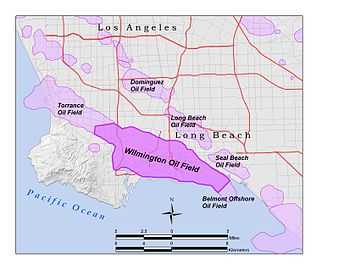Wilmington Oil Field


.jpg)
The Wilmington Oil Field is a prolific petroleum field in Los Angeles County in southern California in the United States. Discovered in 1932, it is the third largest oil field in the United States in terms of cumulative oil production.[1] The field runs roughly southeast to northwest through the Los Angeles Basin, stretching from the middle of San Pedro Bay through Long Beach and east of the Palos Verdes Peninsula. The field originally contained approximately 3 billion barrels (480,000,000 m3) of reserves. As of 2002, approximately 90% of its original reserves had been recovered, leaving approximately 300 million barrels (48,000,000 m3). In 2013, the USGS estimated future potential production from the combined Wilmington-Belmont oilfield could be around 900 million barrels (140,000,000 m3).
The offshore portion of the oil field is developed largely through wells drilled directionally from THUMS Islands, four artificial islands in Long Beach Harbor.[2]
Data
All figures are as of 31 December 2001.
| year discovered | 1932 |
| cumulative production | 2,583.393 million barrels (410,726,700 m3) |
| estimated reserves | 221.499 million barrels (35,215,500 m3) |
| annual production | 15.903 million barrels (2,528,400 m3) |
| producing wells | 1,228 (195,000,000 m³) |
Estimations as of 2013 (based off reserve estimates in 2008[3] and extraction from succeeding years,[4] estimated through July).
cumulative production – 2,750 million barrels (437,000,000 m3)
estimated reserves – 235 million barrels (37,400,000 m3)
annual production – 13 million barrels (2,100,000 m3)
producing wells – 1,428 (in 2008)
estimated year of depletion (based on current rates and reserve estimates) – 2031
A 2013 USGS report estimates that the Wilmington-Belmont oilfield had Original oil-in-place of between 7600 and 12,000 million barrels of oil (MMBO), of which an additional 200 to 1950 MMBO could be produced, with 910 MMBO their best estimate of future production potential. [5]
Geology
The field was discovered with the Ranger Petroleum Corp.'s Watson No. 2 well in 1932, which flowed at 150 bbl per day, and the broad anticline structure itself was discovered in 1936 by the General Petroleum Corp.'s Terminal No. 1 well based on a Reflection seismology survey.[6] An offhore seismic survey in 1954 showed the field extended some miles to the southeast.[7] The anticline plunges to the northwest and is separated from the Torrance Oil Field by a saddle, and is similarly separated from the Huntington Beach Oil Field to the southeast.[8] A series of transform faults divides the field into separate blocks which form barriers to fluid movement and pressure changes.[9] Basement consists of the Catalina Schist and is overlain with up to 8,000 feet of Miocene and Pliocene sediments, the main oil producing zones being the Puente and Repetto sandstones.[10] An unconformity in the Pliocene between the Repetto and the Pico indicates the top of the structure was eroded to a flat surface and later Pliocene and Holocene sediments were deposited horizontally.[11]
Subsidence
Withdrawal of large volumes of oil from the poorly consolidated sediments resulted in compaction of the oil reservoirs, and resultant sinking of the overlying land surface. Subsidence became apparent in 1940, and exceeded 20 feet at the center. Water injection to maintain pressure in the oil reservoirs began in 1953, which eventually stopped further subsidence.[12]
References
- ↑ Otott, George E. Jr & Clarke, Donald D. (1996) "History of the Wilmington Field – 1986–1996". In AAPG Pacific Section, Old Oil Fields and New Life: A Visit to the Giants of the Los Angeles Basin, pp. 17–22.
- ↑ "Historical - oil operations". City of Long Beach. Retrieved 2009-04-30.
- ↑ "Great Oil Fields". Los Angeles Almanac. Given Place Media. 31 December 2008. Retrieved 26 August 2013.
- ↑ "2012 Preliminary Report of California Oil and Gas Production Statistics". Department of Conservation: Division of Oil, Gas, and Geothermal Resources. April 2013. Retrieved 26 August 2013.
- ↑ Remaining Recoverable Petroleum in Ten Giant Oil Fields of the Los Angeles Basin, Southern California, USGS, revised 2-2013
- ↑ Mayuga, M.N., Geology and Development of California's Giant-Wilmington Oil Field, in Geology of Giant Petroleum Fields, Tulsa: American Association of Petroleum Geologists, Memoir 14, p. 159.
- ↑ Mayuga, M.N., Geology and Development of California's Giant-Wilmington Oil Field, in Geology of Giant Petroleum Fields, Tulsa: American Association of Petroleum Geologists, Memoir 14, p. 159.
- ↑ Mayuga, M.N., Geology and Development of California's Giant-Wilmington Oil Field, in Geology of Giant Petroleum Fields, Tulsa: American Association of Petroleum Geologists, Memoir 14, p. 167.
- ↑ Mayuga, M.N., Geology and Development of California's Giant-Wilmington Oil Field, in Geology of Giant Petroleum Fields, Tulsa: American Association of Petroleum Geologists, Memoir 14, pp. 167-169.
- ↑ Mayuga, M.N., Geology and Development of California's Giant-Wilmington Oil Field, in Geology of Giant Petroleum Fields, Tulsa: American Association of Petroleum Geologists, Memoir 14, pp. 163-164.
- ↑ Mayuga, M.N., Geology and Development of California's Giant-Wilmington Oil Field, in Geology of Giant Petroleum Fields, Tulsa: American Association of Petroleum Geologists, Memoir 14, p. 166.
- ↑ Mayuga, M.N., Geology and Development of California's Giant-Wilmington Oil Field, in Geology of Giant Petroleum Fields, Tulsa: American Association of Petroleum Geologists, Memoir 14, p. 159.
External links
| Wikimedia Commons has media related to Wilmington Oil Field. |
Coordinates: 33°46′16″N 118°13′29″W / 33.7710°N 118.2247°W